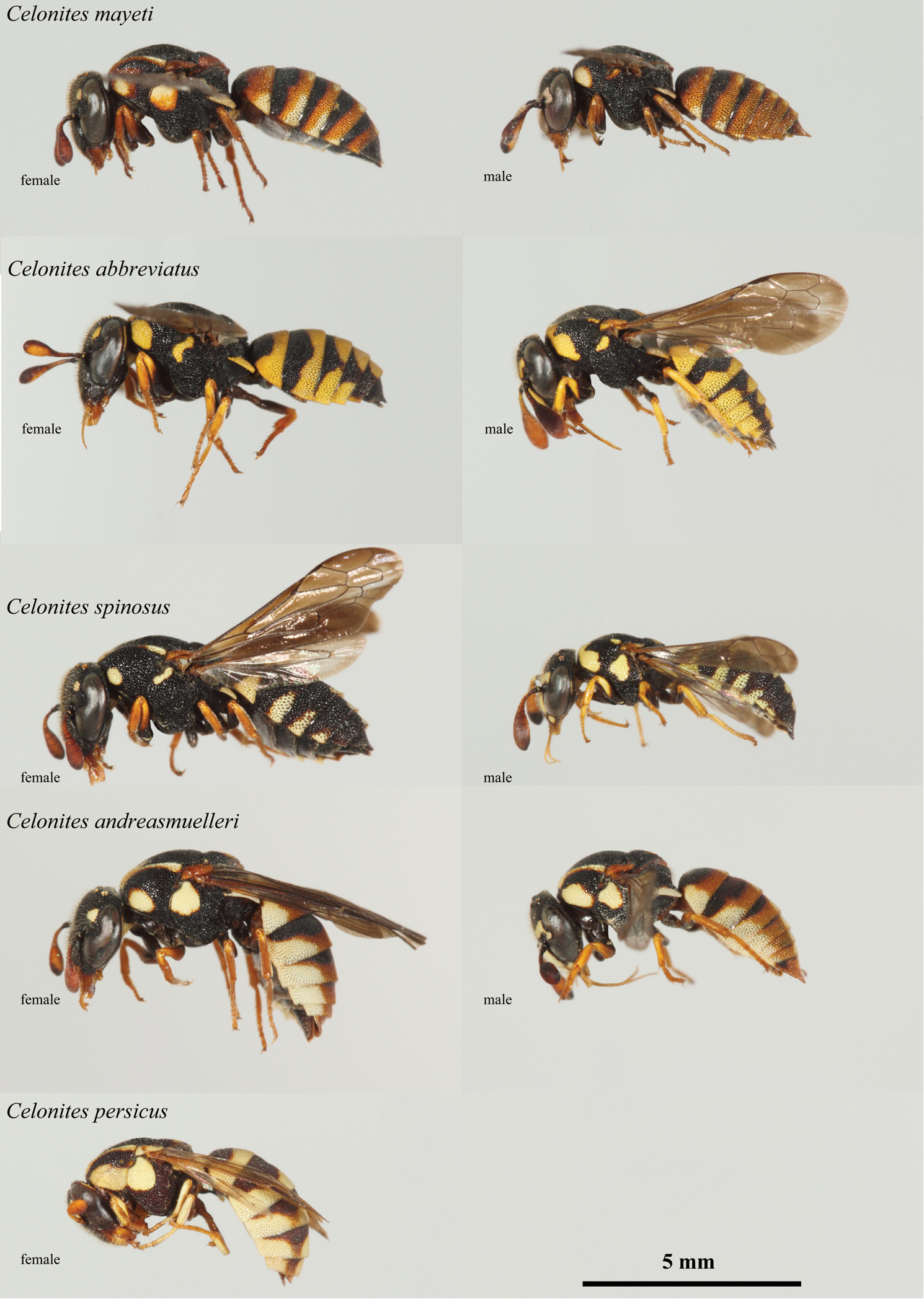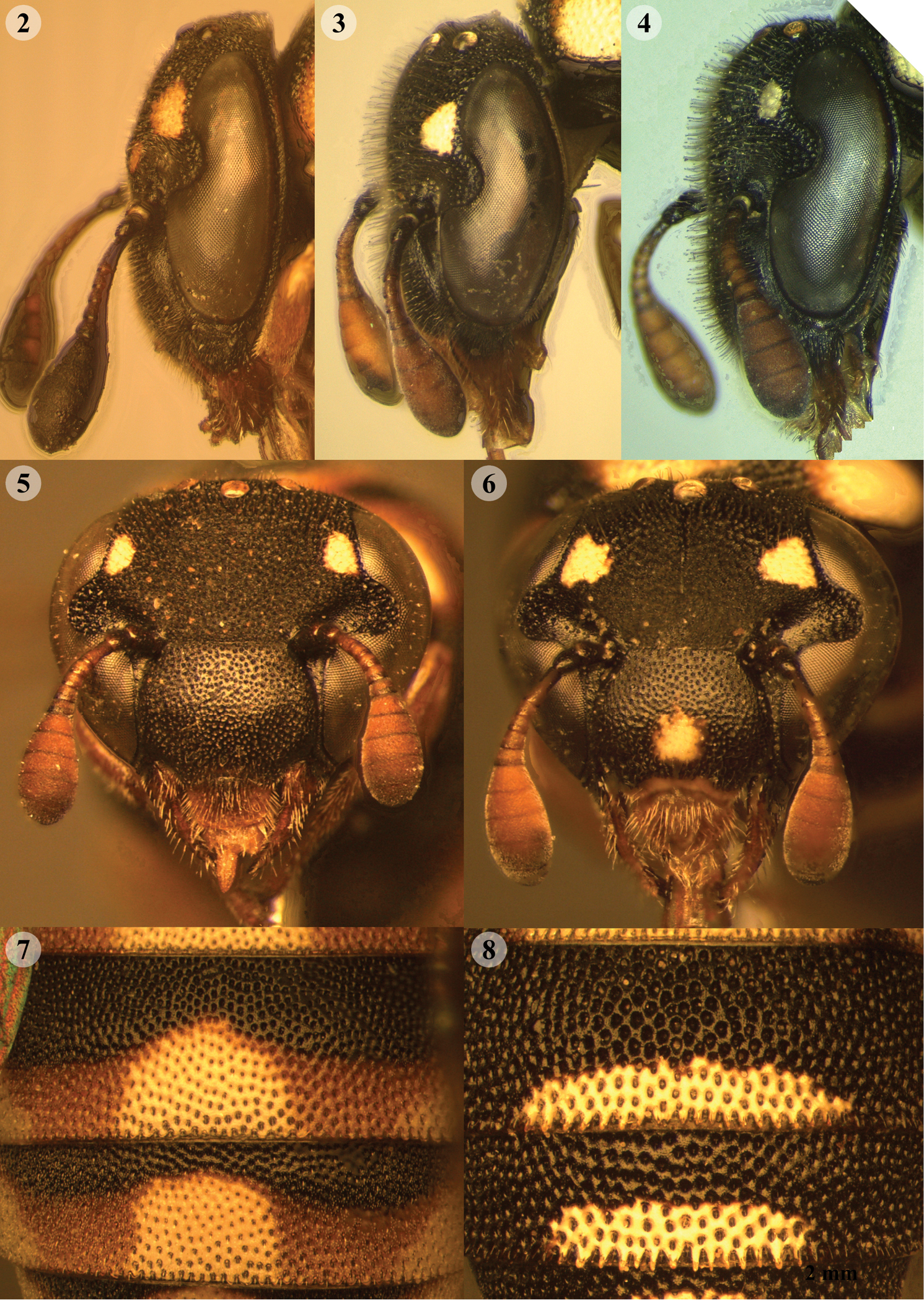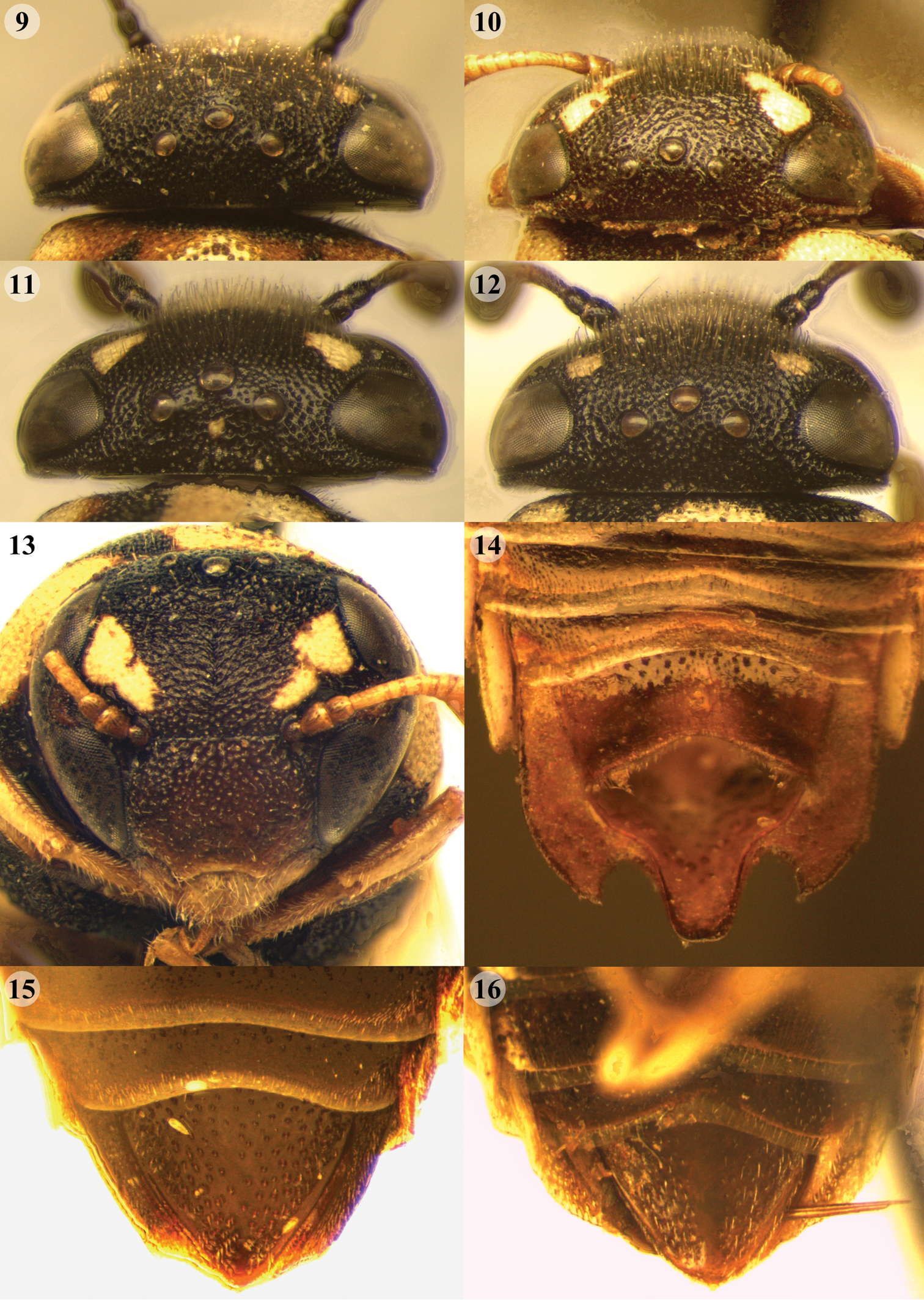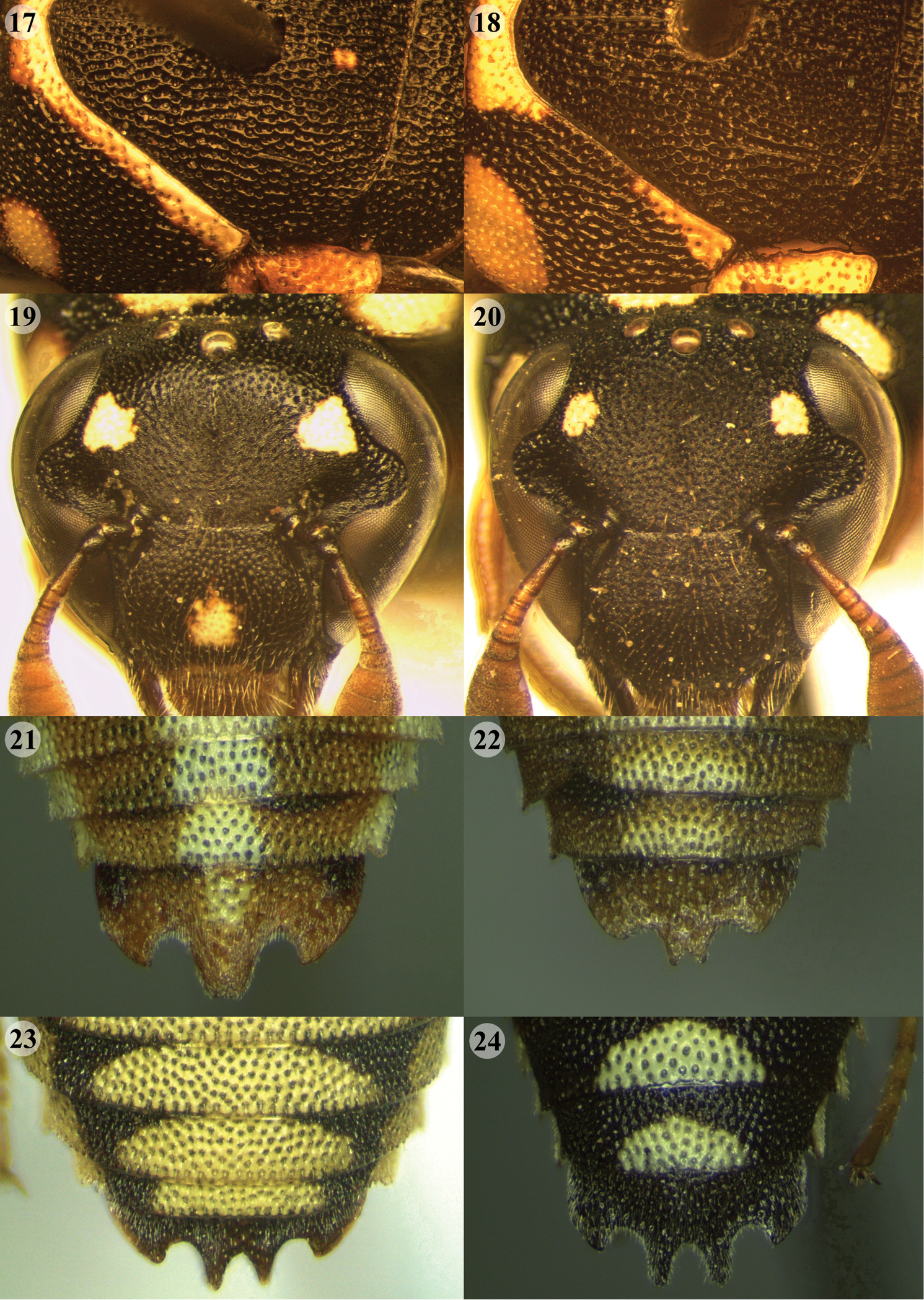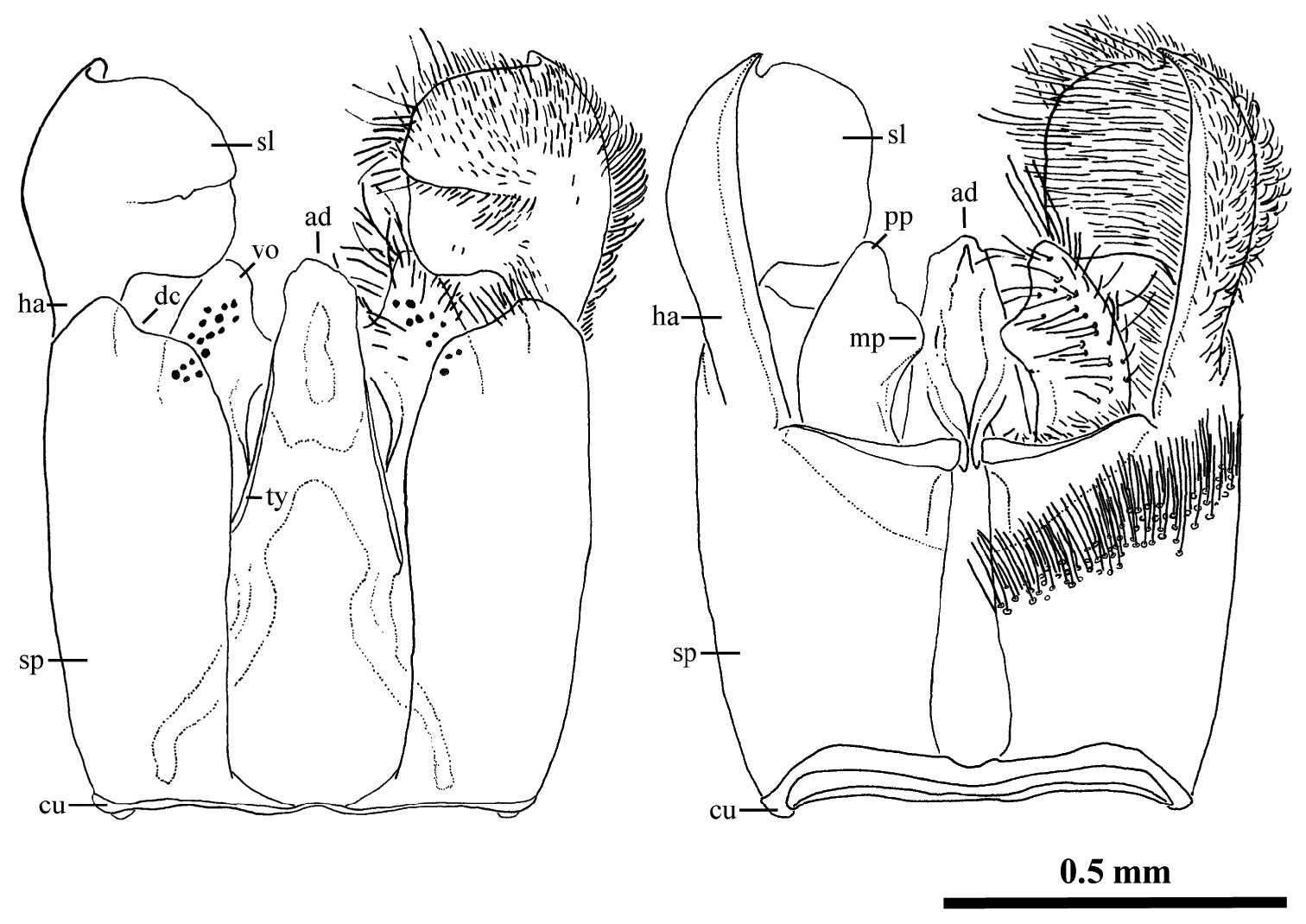






(C) 2013 Volker Mauss. This is an open access article distributed under the terms of the Creative Commons Attribution License 3.0 (CC-BY), which permits unrestricted use, distribution, and reproduction in any medium, provided the original author and source are credited.
For reference, use of the paginated PDF or printed version of this article is recommended.
Celonites andreasmuelleri, a new species of pollen wasp from Israel and Jordan is described. It belongs to the Celonites abbreviatus-complex as indicated by a pollen-collecting apparatus consisting of knobbed setae on clypeus and frons and a corresponding pollen comb on the forelegs. Females of Celonites andreasmuelleri were recorded at nototribic flowers of Ballota sp. (Lamiaceae).
Hymenoptera, Vespidae, Masarinae, Celonites, taxonomy, Palaearctic, Near East, Jordan, Israel
Within the pollen wasps (Masarinae) the genus Celonites constitutes a well defined monophylum (
A series of six females of a so far unknown species of Celonites was recently collected in Jordan by A. Müller, C. Praz and C. Sedivy and handed to me for identification by A. Müller. A corresponding male was captured by A. Dorchin in Israel. The aim of this study is to describe the new species, to characterize its taxonomic position within the genus Celonites and to provide a key to the new species and its close relatives.
urn:lsid:zoobank.org:act:8A992D51-AC3F-444C-B388-294DE682BFA7
http://species-id.net/wiki/Celonites_andreasmuelleri
Figs 1, 3, 6, 7, 11, 14, 17, 19, 21, 25, 261♀ (dbM No. 3072) coll. ETH-Zürich, Jordan, Wadi al Hasa S Al-Karak, 30°54'N, 35°41'E, 20.04.2007 leg. C. Praz, C. Sedivy, A. Müller, visiting Ballota sp. (Lamiaceae).
1♀ (dbM No. 3070) coll. Tel-Aviv University, 1♀ (dbM No. 3071) coll. Oberösterreichisches Landesmuseum Linz, 3♀♀ (dbM No. 3073, 3074, 3075) coll. V. Mauss, all data as holotype. 1♂ (dbM No. 3454), Israel, 16km SE Mizpe Ramon, 30°32.833'N, 34°39.15'E, 815 m a.s.l., 03.05.2011 leg. A. Dorchin, coll. V. Mauss.
Axilla of mesoscutellum with short blunt lateral projection that only slightly projects over adjacent posterior part of tegula. Frons and clypeus covered with pale, stiff pollen collecting setae, about as long as diameter of median ocellus. In females most of these setae with tiny spherical enlargement at tip („knob“), in males setae with distal enlargement only present on frons.
Coloration of body black with extensive whitish-yellow markings, mostly bordered with reddish-brown tinge. Terga richly marked posteriorly with a median and two lateral whitish-yellow markings, interrupted on each side of middle by a broad reddish-brown area, while anterior part is blackish (Figs 1, 7).
In females cuticula on central area of frons densely and strongly shagreened leading to a conspicuous semi-circular dull region covered with knobbed pollen-collecting setae, contrasting distinctly to the adjacent smooth, shiny cuticula on vertex and lateral parts of frons and also with the less densely shagreened cuticula on clypeus (Fig 6, 19).
Males with only two oval-shaped tyloids situated ventrally on segments A9 and A10 of club-shaped antennae. Midcoxa of males with a small but distinct spine at distal end, on anterior side of midcoxa close to its antero-medial angle. Tergum VII markedly lobed posteriorly, with undivided medial projection leading to trilobed appearance of posterior margin (Fig. 21). Posterior margin of sternum VIII emarginate. Emargination medially angled, continuing laterally directly into sides of sternum VIII, without postero-lateral transverse section or small spine at lateral corner of emargination (Fig. 14).
Female. Colour: Black. The following are yellowish-white mostly bordered with reddish-brown tinge: central spot on clypeus; two triangular marks on frons; small median spot on vertex posterior to median ocellus; narrow streak on occiput and gena along occipital carina at dorso-lateral corner of head; large spot on antero-dorsal angle of pronotum (humeral spot); broad stripe along dorso-medial (inner) margin of pronotum; large spot on dorsal mesopleura; tip of axilla; large median spot on scutellum; median third of metanotum; propodeal lamella; median and two lateral markings posteriorly on terga I-V; median and two small lateral spots on tergum VI that do not extend over posterior margin; small spots on postero-lateral edges of sterna II-IV. Reddish-brown are: distal two third of mandible; labrum; narrow stripe along ventral margin of clypeus; pronotal lobe; tegula; large marking between median and lateral spot posteriorly on each side of middle of terga I-V; tergum VI; distal part of femora, tibiae and tarsi. Blackish-brown are: sterna; coxae; trochanters and basal third of femora. Antenna with A1–2 black. A3 proximally black and distally reddish-brown. A4–11 reddish-brown. A11 distally blackish dorsally but distinctly lighter with nearly whitish-yellow spot ventrally that contrasts to distally adjacent black marking of tip of club on A12. Wings translucent blackish-brown.
Structure. Head in front view as long as broad (Fig. 6). Clypeus a little broader than long; shiny with shallow moderately spaced macropunctation (interstices a little larger than diameter of punctures) becoming more distinct towards dorsal margin; slightly shagreened especially dorso-laterally; covered with pale, stiff setae arising from macropunctures; setae about as long as diameter of median ocellus; most with tiny spherical enlargement at tip (“knob”) (Fig. 3); lateral setae with distal ends curved towards centre of clypeus. Frons with shallow moderately spaced macropunctation; cuticula on central area densely and strongly shagreened leading to a conspicuous semi-circular dull area, contrasting distinctly to adjacent smooth shiny cuticula on vertex and lateral parts of frons (Fig. 19); obliquely striated from ventromedial to dorsolateral on both sides of median axis; covered with pale outstanding knobbed setae arising from macropunctures. Frontal line raised to form small carina in centre of frons. Vertex with moderately spaced macropunctation becoming denser, more distinct and somewhat reticulate posterior to ocelli; cuticula smooth shiny with only very few micropunctures; covered with short, thin setae arising from macropunctures. Compound eye sparsely covered with small setae. Gena very narrow; preoccipital carina sharp. Antennal segments A8–12 forming ventrally flattened club nearly 2 times as long as broad (viewed dorsally).
Anterior pronotal carina low but distinctly present along anterior margin of pronotum, especially sharp medially. Posterior pronotal carina forms narrow translucent sinuate crest on humeral angle of pronotum. Dorso-medially pronotum slopes down towards mesoscutum resulting in slight depression along the dorso-medial margin of pronotum; posterior margin raised to carina dorsally in front of tegula; cuticula shiny, with close, reticulate macropunctation, interstices smooth, rounded, nearly without micropunctures; postero-lateral cuticula horizontally striated due to more sharply raised interstices. Cuticula of mesoscutum and mesoscutellum shiny, with close, reticulate macropunctation; interstices slightly raised but rounded and somewhat longitudinally arranged leading to striated appearance especially laterally (Fig. 17); interstices weakly shagreened along median axis and laterally smooth nearly without microsculpture. Mesoscutellum and metanotum medially with small tooth-like projections along posterior margin. Axilla with short blunt lateral projection only slightly projecting over adjacent, somewhat emarginated, posterior part of tegula. Tegula shiny, closely covered by macropunctures except completely smooth central convex area.
Mesepisternum with pronounced epicnemial carina deflexed backwards to run transversely in front of mid coxa; cuticula shiny, with close macropunctation; horizontally striated by raised interstices; area ventral to scrobal groove coarsely punctured with some interstices strongly raised to knife-like edges forming coarse honeycomb-like sculpture. Process at mesepisternal scrobal groove of moderate size; cuticula posteriorly faintly shiny, finely but densely shagreened. Horizontal propodeal triangle laterally delimited by a perpendicular declivity, somewhat laterally produced at postero-lateral edge of propodeal triangle, posteriorly bordered by serrated carina; cuticula shiny, coarsely punctured, interstices almost knife-like. Posterior surface of propodeum striated by strong vertical cuticula-folds; cuticula shiny, without punctuation, weakly coriaceous and covered with short fine pale setae. Cuticula of sides of propodeum and metepisternum shiny, densely horizontally wrinkled. Lateral lamella broad and somewhat convex; lateral margin almost straight; posterior margin straight, not crenate; medially where lamella joins central part of propodeum with a rounded emargination, ventro-medial edge of which produced to a small blunt point; dorsal cuticula of lamella shiny, smooth, with moderately spaced macropunctation. Claws ventrally with small tooth.
Metasomal terga with dark anterior part continuing into posterior pale part by slight declivity especially laterally; postero-lateral corners slightly produced; posterior margins weakly crenulated medially, becoming more pronounced postero-laterally on terga II-IV but crenulation not produced into distinct spines and not projecting over smooth translucent lower posterior margin of terga (Fig. 7); cuticula with silken sheen, densely covered with moderately coarse macropunctation, diameter of punctures and distance between them increasing towards posterior and lateral margins of terga, with about 15 macropunctures along median axis of tergum III; single thin seta arises from bottom of each macropuncture, only slightly protruding over rim of puncture; interstices finely shagreened, moderately covered with very tiny, decumbent, pale setae, all setae orientated towards caudal end. Tergum VI with sides converging almost as straight lines; posterior margin with curved protrusion over central two-thirds, laterally transverse, forming a distinct angle to side.
Metasomal sternum I shiny, with tiny setae but without punctures. Sterna II-V posteriorly with broad strip of asetose, translucent cuticula adjacent to posterior margin of more strongly sclerotized cuticula (Fig. 14); cuticula shiny, finely shagreened, with sparse punctation of shallow, moderate to small macropunctures from which short pale setae arise, becoming denser laterally; small sparse band of setae along posterior sclerotized margin somewhat projecting over anterior part of translucent strip of cuticula. Margin of sternum VI laterally raised to rim; posteriorly protruded into little blunt spine; cuticula shiny, with rather narrow smooth mid-line and at sides strong macropunctures from which short pale setae arise.
Male. Colour: Resembles female, except as follows. Whitish-yellow: large basal spot on mandible; labrum; clypeus except small margin; sinuate band at front of frons, shortly interrupted medially on the supra-antennal area, laterally extending towards upper inner margin of eye where it bends ventrally into ventral half of ocular sinus; large spot on each side of sternum II in addition to small spot on each postero-lateral corner. Vertex completely black. Tip of axilla reddish-brown. Terga I-VI anteriorly blackish, posteriorly with a median and two lateral whitish-yellow markings interrupted on each side of mid-line by a broad reddish-brown area. Tergum VII anteriorly blackish, posteriorly reddish-brown with whitish-yellow median spot. Antenna with A1–2 black; A3–6 anteriorly with whitish-yellow stripe otherwise blackish to reddish-brown; A7–12 reddish-brown running into blackish-brown dorso-posteriorly and at distal end of the club. On ventral side the black tip contrasts to the adjacent light reddish-brown surface of A11.
Structure. Resembles female, except as follows. Clypeus shiny; cuticula smooth with moderately spaced, shallow macropunctation; pale stiff setae arising from macropunctures without distal “knob”; lateral setae with distal ends curved towards centre of clypeus. Frons with semi-circular dull central area smaller and less densely shagreened; bearing at least some knobbed setae. Antenna with two oval-shaped, perhaps sensory, depressions (tyloids) on concave, ventral side of club, situated within antennal segments A9 and A10 and a very small circular cuticula-plate on A8. (Tyloid plate-like structure, distinctly delimited from adjacent cuticula by small rim, diameter about a quarter of width of antennal segment). Midcoxa with small but distinct spine at distal end on anterior side close to anterio-medial angle. Macropunctures posteriorly and laterally on terga somewhat larger and crenulation on terga II-VI more pronounced but also not projecting over the smooth translucent lower posterior margin of terga. Tergum VII with medial projection of posterior margin truncated and undivided, appearing trilobed (Figs 14, 21). Posterior emargination of sternum VIII medially angled laterally continuing directly into sides of sternum, so that a postero-lateral transverse section is lacking (Fig. 14).
Male genitalia as in Figs 25–26. Dorso-medial shovel-like lobe of harpide very large, densely covered ventrally with long setae. Posterior margin of stipes with dorso-medial concavity angled. Sides of stipites mostly parallel along their posterior half, converging slightly anteriorly towards the cupula. Volsella large and broad, extending over antero-medial margin of dorso-medial lobe of harpide; dorsal area with strongly sclerotized, large, dark tubercles; distances between tubercles comparatively large; medial process broad with approximately rectangular distal apex, continuing posteriorly into posterior process at very blunt angle. Sides of thyrsoi converge straight towards posterior end of aedoeagus. Ventral margin of cupula medially barely protruded towards anterior end so that whole dorsal margin of cupula remains visible in ventral view of genital capsule.
Palaearctic species of the Celonites abbreviatus-group with knobbed setae on clypeus and frons that represent the Celonites abbreviatus-complex in lateral view (Celonites mayeti female dbM No. 3462, male dbM No. 3457; Celonites abbreviatus female dbM No. 3458, male dbM No. 3459, Celonites spinosus female dbM No. 3428, male dbM No. 3430; Celonites andreasmuelleri female dbM No. 3072, male dbM No. 3454; Celonites persicus female dbM No. 3455).
Figures 2–8. 2–4 Head of female in lateral view showing pilosity on frons and clypeus 2 Celonites fischeri (dbM No. 3065) 3 Celonites andreasmuelleri (dbM No. 3072) 4 Celonites spinosus (dbM No. 3428). 5–6 Head of female in frontal view 5 Celonites mayeti (dbM No. 3462) 6 Celonites andreasmuelleri (dbM No. 3072). 7–8 Cuticle structure of metasomal terga II and III of female in dorsal view 7 Celonites andreasmuelleri (dbM No. 3073) 8 Celonites spinosus (dbM No. 3428).
9–12 Head of female in dorsal view 9 Celonites mayeti (dbM No. 3456) 10 Celonites persicus (dbM No. 3455) 11 Celonites andreasmuelleri (dbM No. 3072) 12 Celonites spinosus (dbM No. 3428). 13 Head of Celonites persicus female (dbM No. 3455) in frontal view. 14–16 Tip of metasoma from ventral 14 Celonites andreasmuelleri male (dbM No. 3454) 15 Celonites mayeti female (dbM No. 3456) 16 Celonites persicus female (dbM No. 3455).
17–18. Cuticle structure of pronotum and mesoscutum of female in dorsal view 17 Celonites andreasmuelleri (dbM No. 3073) 18 Celonites abbreviatus (dbM No. 3461). 19–20 Cuticle structure of frons and clypeus of female in frontal view 19 Celonites andreasmuelleri (dbM No. 3072) 20 Celonites spinosus (dbM No. 3428). 21–24 Tip of metasoma of male in dorsal view 21 Celonites andreasmuelleri (dbM No. 3454) 22 Celonites mayeti (dbM No. 3457) 23 Celonites abbreviatus (dbM No. 3459) 24 Celonites spinosus (dbM No. 3430).
Male genitalia of Palaearctic species of the Celonites abbreviatus-complex in dorsal (left) and ventral view (middle) and metasomal sternum VIII of male in ventral view (right) (Celonites mayeti dbM No. 3452; Celonites abbreviatus dbM No. 3451, Celonites spinosus dbM No. 3431; Celonites andreasmuelleri dbM No. 3454).
Male genital of Celonites andreasmuelleri (dbM No. 3454) in dorsal (left) and ventral view (right). (Setae only shown on one side of each drawing; Nomenclature follows that of
Measurements. Measurements of the exoskeleton are summarized in Table 1.
Measurements of the exoskeleton of imagines of Celonites andreasmuelleri sp. n. (x = median; min = minimum, max = maximum; measurements were made with a Wild M3 stereomicroscope with maximum magnification 80×, maximum accuracy 0.011 mm, all distances in mm).
| Parameter | Female | Male | ||||
|---|---|---|---|---|---|---|
| x | min | max | n | x | n | |
| lateral ocelli distance | 0.41 | 0.41 | 0.44 | 6 | 0.36 | 1 |
| front./lat. ocellus distance | 0.15 | 0.13 | 0.17 | 6 | 0.12 | 1 |
| compound eyes distance | 1.24 | 1.22 | 1.31 | 6 | 1.07 | 1 |
| A1 length | 0.17 | 0.17 | 0.19 | 6 | 0.15 | 1 |
| A3 length | 0.25 | 0.24 | 0.26 | 6 | 0.24 | 1 |
| A3 width | 0.10 | 0.10 | 0.11 | 6 | 0.11 | 1 |
| A4–5 length | 0.19 | 0.19 | 0.20 | 6 | 0.22 | 1 |
| A8–12 length | 0.72 | 0.70 | 0.76 | 6 | 0.95 | 1 |
| A8–12 width | 0.38 | 0.36 | 0.40 | 6 | 0.43 | 1 |
| antennal sockets distance | 0.73 | 0.67 | 0.74 | 6 | 0.54 | 1 |
| clypeus max. width | 1.03 | 1.01 | 1.07 | 6 | 0.87 | 1 |
| clypeus apical width | 0.51 | 0.50 | 0.61 | 6 | 0.47 | 1 |
| clypeus length | 0.83 | 0.79 | 0.86 | 6 | 0.72 | 1 |
| mesonotum width | 2.59 | 2.49 | 2.66 | 6 | 2.41 | 1 |
| mesoscutum length | 1.82 | 1.76 | 1.90 | 6 | 1.55 | 1 |
| wing length | 5.47 | 5.25 | 5.75 | 6 | 5.33 | 1 |
| R+Sc length | 2.99 | 2.76 | 3.08 | 6 | 2.81 | 1 |
| number of hamuli | 11.0 | 10 | 12 | 6 | 12.0 | 1 |
| femur I length | 1.27 | 1.26 | 1.28 | 2 | 1.17 | 1 |
| tibia I length | 0.89 | 0.84 | 0.90 | 5 | 0.80 | 1 |
| metatarsus I length | 0.51 | 0.47 | 0.55 | 5 | 0.42 | 1 |
| tergum I width | 2.69 | 2.69 | 2.69 | 1 | 2.49 | 1 |
| tergum I length | 0.91 | 0.91 | 0.91 | 1 | 0.79 | 1 |
| tergum II width | 2.72 | 2.63 | 2.77 | 5 | 2.44 | 1 |
| total length | 7.2 | 7.1 | 7.7 | 4 | 7.1 | 1 |
All females from the Jordanian locality were recorded visiting flowers of Ballota sp. (Lamiaceae).
The species is known only from two localities in Jordan and Israel, 90 km apart. Both sites are associated with the drainage system of the Wadi al Jayb.
Named for Dr. Andreas Müller (Zürich, Switzerland) in appreciation of his valuable support and contribution to research into Mediterranean Masarinae.
| 1 | Frons and clypeus covered with especially long setae, 2–5 times as long as diameter of median ocellus. Males with three oval-shaped tyloids ventrally on antennal club |
Celonites phlomis-group (see |
| – | Frons and clypeus covered with distinctly shorter setae, at most about as long as diameter of median ocellus. Males with two oval-shaped tyloids ventrally on antennal club | Celonites abbreviatus-group (2) |
| 2 | Pubescence of frons and to lesser extent also clypeus less dense, consisting of finer setae without knob-like distal swellings, not forming a pollen brush. Setae only 0.5 times as long as diameter of median ocellus (Fig. 2) |
Celonites fischeri-complex (see |
| – | Pubescence of frons and clypeus denser, consisting of long, stiff setae bearing at least a small, knob-like, spherical swelling at the distal end, forming a pollen brush. Knobbed setae about as long as diameter of median ocellus (Figs 3–4) | Celonites abbreviatus-complex (3) |
| 3 | Female | 4 |
| – | Male | 8 |
| 4 | Head appears in front view broader in relation to its length (Figs 5, 13). Cly-peus broad with nearly parallel lateral margins on ventral half. Ocelli smaller, forming an obtuse triangle (Figs 9–10) | 5 |
| – | Head appears in front view more elongated in relation to its length (Fig. 6). Cly- peus with lateral margins more continuously rounded leading to an elongated appearance. Ocelli larger, forming a more acute triangle (Figs 11–12) | 6 |
| 5 | Frons rather shiny, moderately shagreened (Fig. 13). Posterior margin of sternum V deeply concave (Fig. 16). Sternum VI medially with a broad longitudinal area of unpunctured cuticula widening towards the anterior end (Fig. 16). Pale markings whitish yellow, antennae mainly orange-yellow with a little dark spot at the distal end, wings less darkened (Fig. 1) | Celonites persicus Richards, 1962 |
| – | Frons dull, densely shagreened (Fig. 5). Posterior margin of sternum V only slightly concave (Fig. 15). Sternum VI medially only with a small diffuse zone of unpunctured cuticula (Fig. 15). Pale markings whitish yellow with extensive red tinges, antennae mainly dark brown, wings somewhat darker (Fig. 1) | Celonites mayeti Richards, 1962 |
| 6 | Crenulation at the posterior end of terga II-IV produced into small spines that project over the lower, smooth posterior margin of the tergum (Fig. 8). Terga coarsely punctured, with macropunctures nearly two times as large as in the remaining species, leading to a number of about eight macropunctures along the median axis of tergum III (Fig. 8) | Celonites spinosus Gusenleitner, 1966 |
| – | Crenulation at the posterior ends of terga II-IV not produced into spines and not projecting over the smooth lower posterior margin of the tergum (Fig. 7). Terga are distinctly less coarsely punctured, leading to a number of about fifteen macropunctures along the median axis of tergum III (Fig. 7) | 7 |
| 7 | Clypeus, vertex and frons dull and densely shagreened (Fig. 20). Mesoscutum less shiny with dense, moderately coarse punctures separated by knife-like interstices, especially anteriorly resulting in a comb-like appearance (Fig. 18). Pale markings mainly yellow (Fig. 1), except in one rare variety from Switzerland in which they are white. In east Mediterranean specimens yellow markings may have somewhat reddish tinges | Celonites abbreviatus (Villers, 1789) (Celonites hermon Gusenleitner, 2002) |
| – | Clypeus and vertex much more shiny (Fig. 6). Frons with a dull, semi-circular central area of densely shagreened cuticula, contrasting distinctly to the adjacent smooth, shiny cuticula (Fig. 19). Mesoscutum shiny with dense, moderately coarse punctures separated by rounded, not knife-like interstices (Fig. 17). Pale markings whitish yellow mostly bordered with reddish tinges (Fig. 1) | Celonites andreasmuelleriMauss, sp. n. |
| 8 | Tergum VII trilobed (Fig. 14, 21). Posterior emargination of sternite VIII medially bent at an angle of about 135°. Laterally the posterior, angled margin of sternite VIII continues directly into the lateral surface of the sternite without a prominent edge or a distinct spine, so that even a small postero-lateral transverse section is lacking (Fig. 14). Genital as in Fig. 25 | Celonites andreasmuelleriMauss, sp. n. |
| – | Tergum VII quadrilobed, since the median lobe is medially distinctly emarginated (Figs 22–24). Sternum VIII different, with a distinct little spine on each side of the posterior margin (Fig. 25). Genital different | 9 |
| 9 | Sternum VIII deeply angularly emarginated, surface deeply sunk in towards emargination (Fig. 25). Genital as in Fig. 25 | Celonites mayeti Richards, 1962 |
| – | Sternum VIII shallow angularly or even concavely emarginated, surface not much sunk in towards emargination (Fig. 25). Genital different | 10 |
| 10 | Clypeus yellow, except in one rare variety from Switzerland in which it is nearly white. Terga denser but less coarsely punctured (Fig. 23), leading to a number of about 13 macropunctures along the median axis of tergum III. Emargination of sternum VIII medially angled (Fig. 25), laterally with a transverse section well set off by a protruded edge. Genital less broad. Volsella less sclerotized, with a smaller distal-median process (Fig. 25) | Celonites abbreviatus (Villers, 1789) |
| – | Clypeus whitish-yellow. Terga less densely but more coarsely punctured, leading to a number of about 9 macropunctures along the median axis of tergum III. Emargination of sternum VIII more evenly concave (Fig. 25). Genital broader. Volsella strongly sclerotized, with a large distal-median process (Fig. 25) | Celonites spinosus Gusenleitner, 1966 |
As the sexes of Celonites andreasmuelleri are recorded from different localities they are only associated on the basis of general similarity, allowance being made for secondary sexual differences. The association of the sexes should be confirmed by the study of material of both sexes found flying together in one or more localities.
Celonites andreasmuelleri differs from its near relatives in colour, in the structure of the cuticula of the clypeus, frons and vertex associated with the pollen collecting apparatus, and in the shape of sternum VIII and tergum VII that form the walls of the genital chamber of the male and in the morphology of male genitalia. These differences are probably the result of reproductive isolation so that it can be hypothesized that Celonites andreasmuelleri constitutes a distinct biospecies (sensu
The taxonomic position of Celonites andreasmuelleri within the genus Celonites can be deduced from its morphological characters. In Celonites andreasmuelleri the lateral projection of the axilla is short and blunt and projects only slightly over the tegula. This is similar to the morphology of the axilla in members of the subgenus Celonites s.str. (
Females of Celonites andreasmuelleri bear characteristically knobbed setae on frons and clypeus, where they form a distinct pollen brush. A comparable pollen collecting apparatus composed of knobbed setae at the front of the head is known only from Celonites abbreviatus, Celonites hermon, Celonites mayeti, Celonites persicus and Celonites spinosus (
The key to the species of the Celonites abbreviatus-complex does not include the male of Celonites persicus, because it is unknown. Celonites hermon is not included in the key, because the status of this taxon is unclear to me, although I have studied the type. Celonites hermon is very similar to Celonites abbreviatus from which it has been separated because of its extremely long proboscis that reaches the distal end of the abdomen (
I am very much indebted to Leopoldo Castro, Achik Dorchin, Fritz Gusenleitner, Josef Gusenleitner, Christophe Praz, Maximilian Schwarz, Claudio Sedivy, and Claire Villemant for providing specimens. Microphotos were prepared with the kind and indispensable help of Rainer Prosi. Friedrich and Sarah Gess made valuable comments on the manuscript and improved my English.
